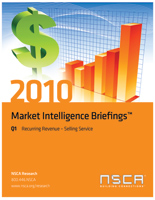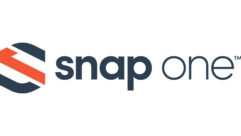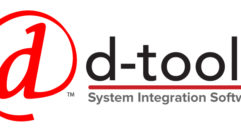

2010 Business Trends Include Recurring Revenue
Mar 21, 2010 5:17 PM
NSCA’s latest Market Intelligence Briefing (MIB) report, Recurring Revenue—Selling Service, analyzes six key recurring revenue streams for systems contractors.
Related Links

NSCA Creates 24/7 Networking Opportunities for Industry Professionals
NSCA has established its presence on Facebook, LinkedIn, Twitter, and the WordPress blog site to provide the latest news, special savings opportunities, and tips to keep commercial electronic systems businesses successful….

NSCA Education Foundation Raises $100,000 in 2009
The NSCA Education Foundation raised $100,000 in 2009 to continue its goal to create and provide educational opportunities for students seeking a career path within the commercial electronic systems industry. …

The NSCA at InfoComm 2010 website is now live for industry professionals….
Contractors acknowledge that the financial health of the business is not measured by total annual revenues, but rather by the timing of those revenues against the outlay of expenses. This fact underscores the benefit of recurring revenue streams.
Contractors identified six major categories of service when surveyed for this report, including:
- Service agreements/contracts: More than 74 percent offer this service in the corporate/industrial, educational, and government facilities markets.
- Preventative maintenance agreements/contracts: Sixty-two percent of contractors find this a profitable service in the education, corporate, and healthcare markets.
- Managed service agreements: While remote monitoring of systems is relatively new, 21 percent of those surveyed are involved in it and attribute it to 5.9 percent of gross revenue.
User training agreements: Twenty-one percent of respondents provide product training, 24 percent of which just began in 2009 showing recent growth.
- Security, life safety, or fire alarm monitoring services: Twenty-four percent of contractors are involved in this specific section of the industry; almost half of this group has offered these services for more than 16 years.
- Content supply and creation: It’s no surprise that 20 percent of companies, mostly small businesses, are involved in this extremely niche market.
“The benefits of recurring revenue streams go far beyond cash flow and revenue contribution,” says Chuck Wilson, NSCA executive director. “Many contractors increase their service business—recognizing that service is a ‘product’ that companies should strive to make tangible and easy for customers to understand.”
These services lead to an enhanced, ongoing connection to decision-makers by building on customer relations and creating better brand recognition.
NSCA’s quarterly MIBs provide NSCA members with current data on key industry issues, complete with statistical results, interpretation, implications, market knowledge, and implementation goals. For more information or to view the report, visit www.nsca.org/mib.










